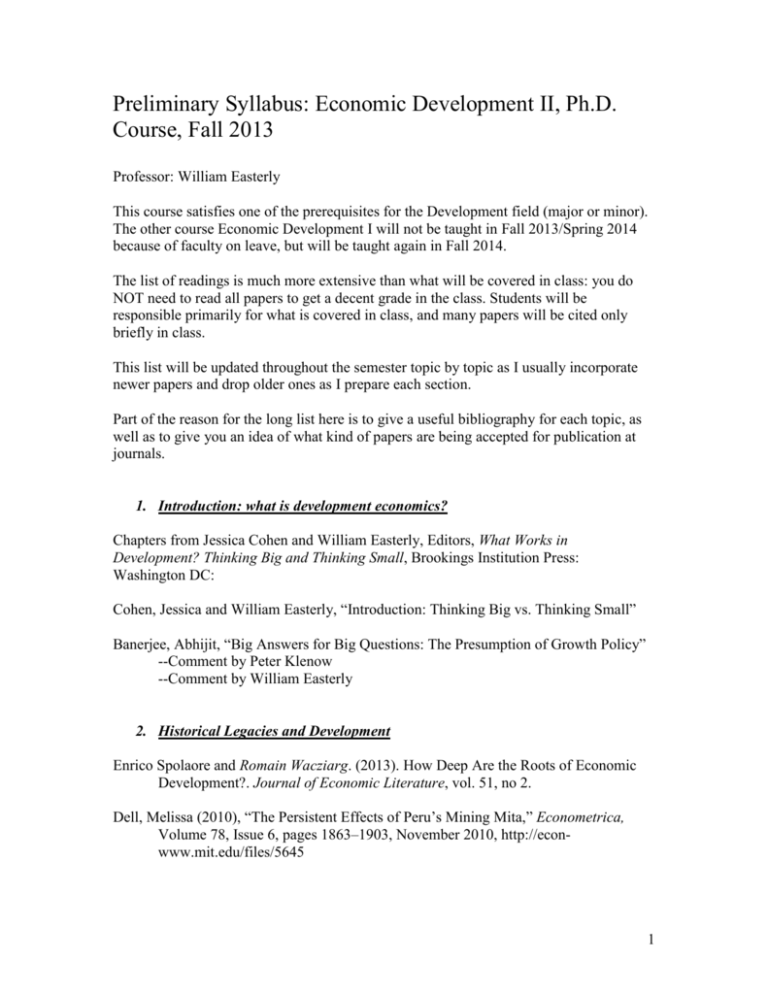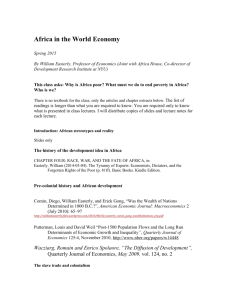Syllabus: Economic Development I
advertisement

Preliminary Syllabus: Economic Development II, Ph.D. Course, Fall 2013 Professor: William Easterly This course satisfies one of the prerequisites for the Development field (major or minor). The other course Economic Development I will not be taught in Fall 2013/Spring 2014 because of faculty on leave, but will be taught again in Fall 2014. The list of readings is much more extensive than what will be covered in class: you do NOT need to read all papers to get a decent grade in the class. Students will be responsible primarily for what is covered in class, and many papers will be cited only briefly in class. This list will be updated throughout the semester topic by topic as I usually incorporate newer papers and drop older ones as I prepare each section. Part of the reason for the long list here is to give a useful bibliography for each topic, as well as to give you an idea of what kind of papers are being accepted for publication at journals. 1. Introduction: what is development economics? Chapters from Jessica Cohen and William Easterly, Editors, What Works in Development? Thinking Big and Thinking Small, Brookings Institution Press: Washington DC: Cohen, Jessica and William Easterly, “Introduction: Thinking Big vs. Thinking Small” Banerjee, Abhijit, “Big Answers for Big Questions: The Presumption of Growth Policy” --Comment by Peter Klenow --Comment by William Easterly 2. Historical Legacies and Development Enrico Spolaore and Romain Wacziarg. (2013). How Deep Are the Roots of Economic Development?. Journal of Economic Literature, vol. 51, no 2. Dell, Melissa (2010), “The Persistent Effects of Peru’s Mining Mita,” Econometrica, Volume 78, Issue 6, pages 1863–1903, November 2010, http://econwww.mit.edu/files/5645 1 Dell M. Path Dependence in Development: Evidence from the Mexican Revolution. 2012. Feyrer, James D., and Bruce Sacerdote, “Colonialism and Modern Income: Islands as Natural Experiments,” Review of Economics and Statistics, May 2009, 91(2): 245–262 http://ideas.repec.org/a/tpr/restat/v91y2009i2p245-262.html Nunn, Nathan, “Historical Legacies: A Model Linking Africa’s Past to its Current Underdevelopment”, Journal of Development Economics, 83 (2007), 157–175. http://www.economics.harvard.edu/faculty/nunn/files/legacy_jde.pdf Nunn, Nathan, “The Long-Term Effects of Africa’s Slave Trades,” Quarterly Journal of Economics, 123 (2008), 139–176. http://www.economics.harvard.edu/faculty/nunn/files/empirical_slavery.pdf Sacerdote, Bruce. “Slavery and the Intergenerational Transmission of Human Capital."The Review of Economics and Statistics, Vol. 87, Issue 2 - May, 2005. http://www.dartmouth.edu/~bsacerdo/wpapers/Slavery3.pdf Putterman, Louis and David Weil “Post-1500 Population Flows and the Long Run Determinants of Economic Growth and Inequality”, Quarterly Journal of Economics 125:4, November 2010, http://www.nber.org/papers/w14448 Comin, Diego, William Easterly, and Erick Gong, “Was the Wealth of Nations Determined in 1000 B.C.?”, American Economic Journal: Macroeconomics 2 (July 2010): 65–97 http://williameasterly.files.wordpress.com/2010/08/60_easterly_comin_gong_wealthofnations_prp.pdf Wacziarg, Romain and Enrico Spolaore, “The Diffusion of Development”, Quarterly Journal of Economics, May 2009, vol. 124, no. 2 3. Culture, Social Norms, and Development Nunn N, Alesina A, Giuliano P. On the Origins of Gender Roles: Women and the Plough. Quarterly Journal of Economics. 2013;128(2):469-530. Nunn, Nathan, and Leonard Wantchekon, “The Trans-Atlantic Slave Trade and the Evolution of Mistrust in Africa: An Empirical Analysis,” American Economic Review, 2011, Vol 11, No 7, 5221-3252. http://www.economics.harvard.edu/faculty/nunn/files/Trust_AER_Rev2.pdf Luigi Guiso, Paola Sapienza, Luigi Zingales, Civic Capital as the Missing Link, in Jess Benhabib, Alberto Bisin and Matthew Jackson, editors, Handbook of Social Economics, North Holland 2010 2 Alberto Bisin and Thierry Verdier, The Economics of Cultural Transmission and Socialization, in Jess Benhabib, Alberto Bisin and Matthew Jackson, editors, Handbook of Social Economics, North Holland 2010 http://www.nyu.edu/econ/user/bisina/BV%20HSOC.pdf Philippe Aghion, Yann Algan, Pierre Cahuc and Andrei Shleifer, Regulation and Distrust, Quarterly Journal of Economics, August, 2010. http://www.economics.harvard.edu/faculty/aghion/files/Regulation%20and%20Di strust.pdf Licht, Amir N., Chanan Goldschmidt, and Shalom H. Schwartz (2007), Culture rules: The foundations of the rule of law and other norms of governance, Journal of Comparative Economics, 35 659–688 Tabellini, Guido, “The Scope of Cooperation: Values and Incentives,” Quarterly Journal of Economics, Vol. 123, 2008, pp. 905–950. Yuriy Gorodnichenko and Gerard Roland "Culture, institutions and the wealth of nations," 2013, http://emlab.berkeley.edu/~ygorodni/gorrol_culture.pdf Miguel, Edward, and Ray Fisman, “Corruption, Norms and Legal Enforcement: Evidence from Diplomatic Parking Tickets,” Journal of Political Economy, vol. 115, 2007, pp. 1020–1048. Miguel, Edward, Sebastian Saiegh, and Shanker Satyanath, Civil War Exposure and Violence, Economics and Politics, Vol. 23 (1), March 2011. http://elsa.berkeley.edu/~emiguel/pdfs/miguel_soccer.pdf 4. The neoclassical model of development: Factor Accumulation v. Productivity Hsieh, Chang Tai, What Explains the Industrial Revolution in East Asia? Evidence from the Factor Markets, American Economic Review, June 2002. http://www.wws.princeton.edu/~chsieh/aea3.pdf Hsieh, Chang Tai and Peter Klenow, Relative Prices and Relative Prosperity, American Economic Review, 2007, http://www.klenow.com/RPandRP.pdf Easterly, William and Ross Levine, “It’s not factor accumulation: stylized facts and growth models”, World Bank Economic Review, Volume 15, Number 2, 2001 Klenow, Peter and Andres Rodriguez-Clare (1997). “The Neoclassical Revival in Growth Economics: Has It Gone Too Far?” NBER Macroeconomics Annual 1997, Volume 12, 73-103. 3 Caselli, F. and J Feyrer The Marginal Product of Capital, The Quarterly Journal of Economics, May 2007, Vol. 122, No. 2, Pages 535-568 Banerjee, Abhijit, Esther Duflo, and Kaivan Munshi “The (Mis)allocation of Capital,” Journal of the European Economic Association 1(2-3): 484-494, 2003 Banerjee, Abhijit and Esther Duflo “Growth Theory through the Lens of Development Economics,” in Steve Durlauf and Philippe Aghion, (eds.),Handbook of Economic Growth, Elsevier Science Ltd.-North Holland: 2005, Vol. 1A, pp. 473-552. Charles I. Jones, Intermediate Goods and Weak Links in the Theory of Economic Development, American Economic Journal: Macroeconomics 3 (April 2011): 1–28 5. Endogenous Growth Models: Increasing v. Constant v. Diminishing Returns Charles I. Jones and Paul M. Romer , The New Kaldor Facts: Ideas, Institutions, Population, and Human Capital, American Economic Journal: Macroeconomics 2010, 2:1, 224–245 http://www.aeaweb.org/articles.php?doi=10.1257/mac.2.1.224 Jones, Chad (2005) “Growth and Ideas”, in Aghion and Durlauf, eds., Handbook of Economic Growth, http://www.econ.berkeley.edu/~chad/handbook200.pdf Galor, Oded, "From Stagnation to Growth: Unified Growth Theory," Handbook of Economic Growth, 2005, pp.171-293 Galor, Oded and David N. Weil, "Population, Technology and Growth: From Malthusian Stagnation to the Demographic Transition and Beyond," American Economic Review, 90, September 2000, 806-828 Galor Oded “Comparative Economic Development: Insights from Unified Growth Theory,” International Economic Review, 51, 1-44 (February 2010). 4 6. Political economy of ideas and ideologies in development Benabou, Richard and Jean Tirole. "Belief In A Just World And Redistributive Politics," Quarterly Journal of Economics, 2006, v121(2,May), 699-746. Benabou, Roland. Ideology," Journal of the European Economic Association April-May 2008 6(2–3), 321–352. http://www.princeton.edu/~rbenabou/papers/jeea%202008%206%202-3%20321.pdf Roland Benabou and Jean Tirole, "Identity, Morals and Taboos: Beliefs as Assets," The Quarterly Journal of Economics, 126, (2011), 805-855. http://www.princeton.edu/~rbenabou/QJE%202011.pdf Glaeser, Edward, The Political Economy of Hatred Quarterly Journal of Economics 120(1) (2005): 45-86. Glaeser, Edward. “Paternalism and Psychology.” The University of Chicago Law Review 73, 1 (2006): 133-156. http://www.nber.org/papers/w11789 7. Democracy, Political Economy, Leaders, and Development Acemoglu, Daron and James A. Robinson (2005) Economic Origins of Dictatorship and Democracy, New York: Cambridge University Press Besley, Timothy, Torsten Persson, Daniel Sturm, “Political Competition and Economic Performance: Theory and Evidence from the United States”, Review of Economic Studies, 77(3), 1329-1352, 2010 http://econ.lse.ac.uk/staff/tbesley/papers/bps.pdf Aghion, Philippe, Alberto Alesina, and Francesco Trebbi “Endogenous Political Institutions,” Quarterly Journal of Economics, May 2004, 119: 565-612 http://post.economics.harvard.edu/faculty/alesina/papers/aatqje.pdf Persson, Torsten and Guido Tabellini, “Democratic Capital: The Nexus of Political and Economic Change”, American Economic Journal: Macroeconomics, 2010. Daniel Berger, William Easterly, Nathan Nunn, Shanker Satyanath, “Commercial Imperialism? Political Influence and Trade During the Cold War,” American Economic Review, April 2013 Daniel Berger, Alejandro Corvalan, William Easterly, Shanker Satyanath “Do superpower interventions have short and long term consequences for democracy?” Journal of Comparative Economics, Volume 41, Issue 1, February 2013, pages 22-34. 5 Jones, Benjamin F., and Benjamin A. Olken. 2005. “Do Leaders Matter? National Leadership and Growth since World War II.” Quarterly Journal of Economics, 120(3): 835–64. http://econ-www.mit.edu/files/2915 Benjamin F. Jones and Benjamin A. Olken, “Hit or Miss? The Effect of Assassinations on Institutions and War,” American Economic Journal: Macroeconomics 2009, 1:2, 55–87 http://econ-www.mit.edu/files/3055 William Easterly and Steven Pennings, “How Much Do Leaders Affect Growth? Not as Much as You Think,” May 2013. 8. Foreign Aid: Saving the World v. One Step At a Time Easterly, William (2009), “Can the West Save Africa?”, Journal of Economic Literature Werker, Eric, Faisal Z. Ahmed, and Charles Cohen. 2009. "How Is Foreign Aid Spent? Evidence from a Natural Experiment." American Economic Journal: Macroeconomics, 1(2): 225–44. Rajan, Raghuram G. and Arvind Subramanian, “Aid and Growth: What Does the CrossCountry Evidence Really Show?”, July 2007, Review of Economics and Statistics Easterly, William and Claudia Williamson, Rhetoric versus Reality: The Best and Worst of Aid Agency Practices, World Development, 2011 Easterly, William, Ross Levine, and David Roodman "New Data, New Doubts: A Comment on Burnside and Dollar's "Aid, Policies, and Growth", American Economic Review, June 2004 Djankov, Simeon, Jose Montalvo and Marta Reynal-Querol, “The Curse of Aid”, Journal of Economic Growth, June 2009. 9. Thinking Big vs. Thinking Small in Development Durlauf, S., P. Johnson and J. Temple “Growth Econometrics,” with, in Handbook of Economic Growth, P. Aghion and S. Durlauf, eds., Amsterdam: North Holland, 2006. Gernot Doppelhofer, Ronald Miller, and Xavier Sala-i-Martin, "Determinants of LongTerm Growth: A Bayesian Averaging of Classical Estimates (BACE) Approach," American Economic Review, September 2004 6 Ciccone, Antonio and Marek Jarocinski, Determinants of Economic Growth: Will Data Tell? , American Economic Journal: Macroeconomics, October 2010 Duflo, Esther, Rachel Glennerster, and Michael Kremer (2008) “Using Randomization in Development Economics Research: A Toolkit” in Handbook of Development Economics, Volume 4, North-Holland Kremer, Michael and Alaka Holla (2008) “Pricing and Access: Lessons from Randomized Evaluations in Education and Health”, in W. Easterly and J. Cohen, editors, What Works in Development? Thinking Big vs. Thinking Small, Brookings Institution Press. Kremer, Michael, Jessica Leino, Edward Miguel, and Alix Peterson Zwane. 2011. Spring Cleaning: Rural Water Impacts, Valuation, and Property Rights Institutions. Quarterly Journal of Economics 126, no. 1: 145-205 Kremer, Michael, Esther Duflo, and Jon Robinson. 2011. Nudging Farmers to Use Fertilizer: Theory and Experimental Evidence from Kenya. American Economic Review 101, no. 6 (October 2011): 2350-90. Esther Duflo, Human values and the design of the fight against poverty,The Tanner Lectures on Human Values, Harvard University, May 2012 Katherine Casey, Rachel Glennerster, and Edward Miguel, Reshaping Institutions: Evidence on Aid Impacts Using a Pre-Analysis Plan, Quarterly Journal of Economics, 2012, 127(4), 1755-1812 Angus Deaton, Instruments, randomization, and learning about development, Journal of Economic Literature, 48 (June 2010), pp. 424-455 Angus Deaton, 2012, NYU Development Research Institute Annual Conference, Lecture on Banerjee and Duflo, Poor Economics, (video link to 35 minute lecture) http://nyudri.org/events/past-events/annual-conference-2012-debates-indevelopment/ 7









